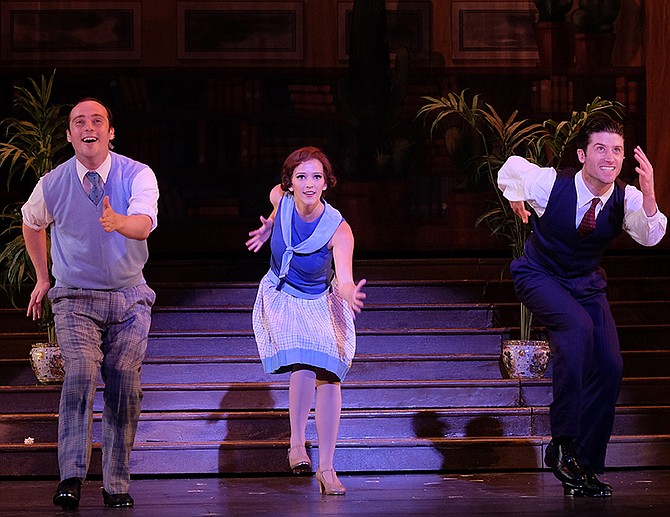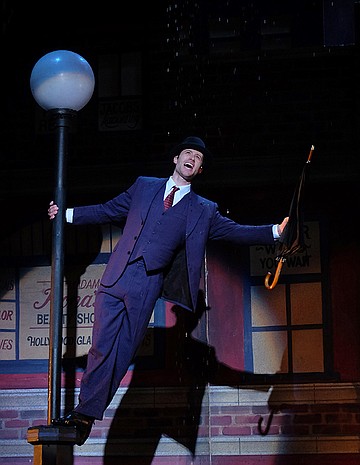 Facebook
Facebook
 X
X
 Instagram
Instagram
 TikTok
TikTok
 Youtube
Youtube

Aw come on, you mean the movie where Gene Kelly — with a glow-ree-us feelin' — kick-splashes puddles, spins that black umbrella, glides with gymnastic grace, and joy-hangs from the side of a lamp-post didn’t win the Academy Award for 1952? Plus Donald O’Connor making ‘em laugh for all eternity, and 19-year-old Debbie Reynolds hoofing with such classy hoofers – and it still didn’t win? And American in Paris did?
Oh, Oscar: for SHAME!!!
The original movie’s so iconic that when performed on stage, even in a competent production by San Diego Musical Theatre, it looks mortal. Having to make big set changes, instead of the fluidity of the film, is a factor, also the jumpy book and its threadbare through-line, based on the Betty Comden/Adolph Green’s screenplay. Except for the comeuppance ending, the second act plot’s just a wagging tail.

Someone observed that, unlike most musicals made for the movies, Singin’ is actually about something other than just romance. It takes place during Hollywood’s sudden transition from silent films to “talking pictures” in 1927.
When The Jazz Singer synchronizes Al Jolson’s songs with his movements, Hollywoodland goes awry, including the careers of Don Lockwood and Lina Lamont, silent screen matinee idols.
Don’s voice is mellifluous enough to switch from “dumbshows” to movies for the eye and the ear. But Lina’s? That Jersey pip-squeaker? Not even six decades at the Henry Higgins School of Proper Elocution could resurrect her.
(One of the funnier parts of the dialogue: the vocal style the speech teacher wants her to master is just as strange and affected, in its own way, as Lina’s.)
As Lina, Andi Davis’s platinum blond wig, strut, and saucy ego are just right. There’s an irony here: Lina’s the villain of the piece. Yet her “look” will inspire budding actresses to bleach their hair and bus to Tinseltown way into the 1930s.
Brittany Rose-Hammond displays a clear soprano voice and dancing expertise as Kathy Seldon, the star-to-be. Just prior to singing “My Lucky Star,” the book gives Kathy a major, produce-now-or-else build-up. Rose-Hammond soars above the hype.
As Cosmo Brown, the Donald O’Connor part, Cameron Lewis gives his all for the “Make ‘em Laugh” show-stopper, though memories of O’Connor’s brilliant inventions can intrude.
Comparisons may be odious, but also inevitable. As a dancer and a singer (though he tends to lag behind Don LeMaster’s expert band at times), Brandon Davidson is capable. But his Don Lockwood is no Gene Kelly. In the famous “Singin’ in the Rain” sequence — aided by SDMT’S “recycled water effect” — his by-the-numbers steps lack Kelly’s speed, athleticism, and unfettered verve.
SDMT’s design work was a mix. Janet Pitcher’s coordinated costumes evoked the Jazz Age effectively. The uncredited set, a stage-wide, imitation marble staircase, made for some pace-dulling changes. And the miking was cranked so high, at times, it made the numbers sound as tinny as Lina’s voice when told to recite the Gettysburg Address: “What do I care where Gettysburg lives!”
Best of Show: the program doesn’t credit who made the wonderful, black and white, videos of Don and Lina on the silent screen. The lighting, the flickering movements, the sometimes amateurish angles — all look REALLY original.


Aw come on, you mean the movie where Gene Kelly — with a glow-ree-us feelin' — kick-splashes puddles, spins that black umbrella, glides with gymnastic grace, and joy-hangs from the side of a lamp-post didn’t win the Academy Award for 1952? Plus Donald O’Connor making ‘em laugh for all eternity, and 19-year-old Debbie Reynolds hoofing with such classy hoofers – and it still didn’t win? And American in Paris did?
Oh, Oscar: for SHAME!!!
The original movie’s so iconic that when performed on stage, even in a competent production by San Diego Musical Theatre, it looks mortal. Having to make big set changes, instead of the fluidity of the film, is a factor, also the jumpy book and its threadbare through-line, based on the Betty Comden/Adolph Green’s screenplay. Except for the comeuppance ending, the second act plot’s just a wagging tail.

Someone observed that, unlike most musicals made for the movies, Singin’ is actually about something other than just romance. It takes place during Hollywood’s sudden transition from silent films to “talking pictures” in 1927.
When The Jazz Singer synchronizes Al Jolson’s songs with his movements, Hollywoodland goes awry, including the careers of Don Lockwood and Lina Lamont, silent screen matinee idols.
Don’s voice is mellifluous enough to switch from “dumbshows” to movies for the eye and the ear. But Lina’s? That Jersey pip-squeaker? Not even six decades at the Henry Higgins School of Proper Elocution could resurrect her.
(One of the funnier parts of the dialogue: the vocal style the speech teacher wants her to master is just as strange and affected, in its own way, as Lina’s.)
As Lina, Andi Davis’s platinum blond wig, strut, and saucy ego are just right. There’s an irony here: Lina’s the villain of the piece. Yet her “look” will inspire budding actresses to bleach their hair and bus to Tinseltown way into the 1930s.
Brittany Rose-Hammond displays a clear soprano voice and dancing expertise as Kathy Seldon, the star-to-be. Just prior to singing “My Lucky Star,” the book gives Kathy a major, produce-now-or-else build-up. Rose-Hammond soars above the hype.
As Cosmo Brown, the Donald O’Connor part, Cameron Lewis gives his all for the “Make ‘em Laugh” show-stopper, though memories of O’Connor’s brilliant inventions can intrude.
Comparisons may be odious, but also inevitable. As a dancer and a singer (though he tends to lag behind Don LeMaster’s expert band at times), Brandon Davidson is capable. But his Don Lockwood is no Gene Kelly. In the famous “Singin’ in the Rain” sequence — aided by SDMT’S “recycled water effect” — his by-the-numbers steps lack Kelly’s speed, athleticism, and unfettered verve.
SDMT’s design work was a mix. Janet Pitcher’s coordinated costumes evoked the Jazz Age effectively. The uncredited set, a stage-wide, imitation marble staircase, made for some pace-dulling changes. And the miking was cranked so high, at times, it made the numbers sound as tinny as Lina’s voice when told to recite the Gettysburg Address: “What do I care where Gettysburg lives!”
Best of Show: the program doesn’t credit who made the wonderful, black and white, videos of Don and Lina on the silent screen. The lighting, the flickering movements, the sometimes amateurish angles — all look REALLY original.
Comments